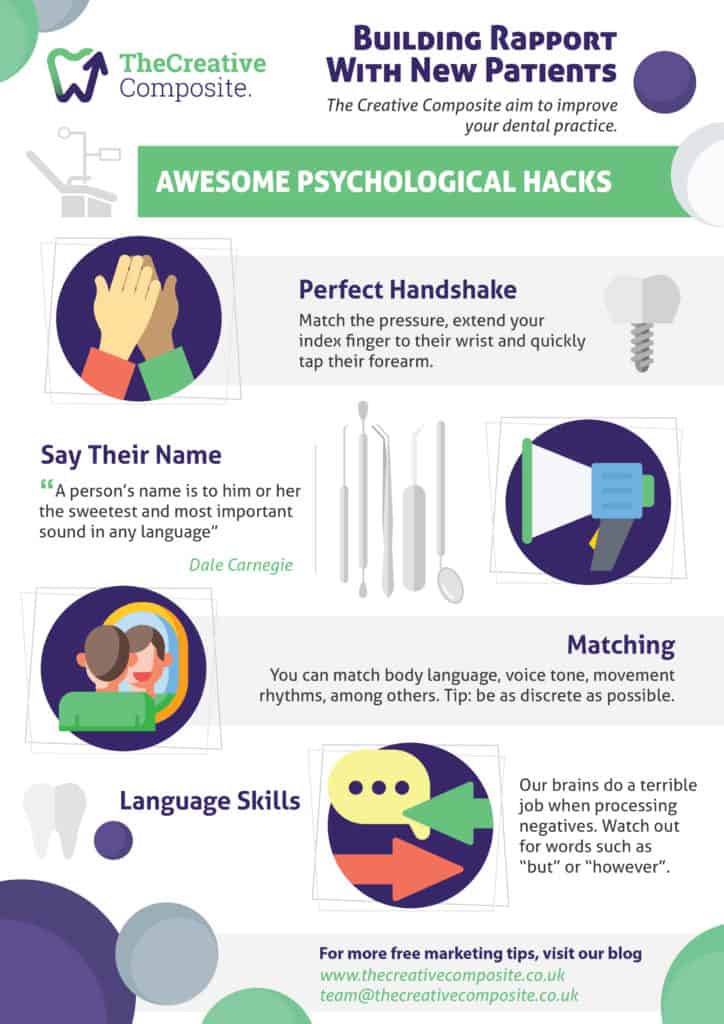I’ve got a confession to make: I love listening to the reasons that prevent dental practice owners’ from building rapport with new patients.
You might think this is weird, or strange. But I do it for one important reason: I’m paranoid about myself not building rapport with clients either.
Not “unhealthy paranoid”. I just look for mistakes other people make so I don’t make those same mistakes.
This post promises to reveal to you the top 5 effortless tricks from psychology that you can use to establish good relationships with new patients. And with everyone really.
These 5 ways to use psychology in your dental practice relate to the handshakes, “say my name, say my name”, matching, pacing and leading, and language skills.
Ps. Don’t panic if any of those terms sound too fancy. In the following lines, you’ll discover that’s far from reality.
The Ultimate Handshake
Handshakes are one of the first steps when you are interacting with another person. It constitutes an accepted part of an introduction in our society and it’s something that both you and I, do almost daily.
There’s no doubt you’ll want to come across friendly and sociable. The impression your patients will have of you because of your handshake will endure. Therefore, you want it to be favourable.
Above all, there are 4 main types of handshakes that will prevent you from building rapport with your new patients. The ones you will avoid no matter what are:
- Knuckle cruncher
- Dead fish
- Submission twist
- Over-sincere friend
Remember that your handshake influences your patients instantly and emotionally. How you give a handshake is unconsciously registered. That means that within the first 2-3 seconds, your patient gets a feeling about you.
And we said this impression lasts forever. Literally! No matter how much you try after, you won’t be able to change that impression.
Take a look at the picture above and print the image in your brain. This is the visual representation of the handshake that will assist you in building rapport with your patients. There are 3 steps for the perfect handshake, that one you see on the picture. They are:
- Do this in the first microsecond of shaking someone’s hand: MATCH the pressure.
- When shaking hands, extend your index finger to their wrist. Like you can see in the picture. This creates a sense of warmth and trust.
- Quickly reach forward and tap them on the forearm and say, “nice to meet you”. This is just a tap, this means quickly in and quickly out again.
The Science Backing This Up
When you match pressure, patients are going to immediately like your handshake. In addition, they will unconsciously think “this person is good”. And they will think that because they will think “this person is like me”. See building rapport with patients wasn’t that difficult!
What’s more, because we all have personal space, we need to trust people to let them into our space. By extending your index finger you are subconsciously making your patient generate trust to justify you being in their space.
The same applies to build rapport by tapping your patient’s forearm. It won’t be considered invasive at all. And they will subconsciously build trust to justify it.
Use Your Patient’s Name For Building Rapport Instantly
Dale Carnegie once said, “A person’s name is to him or her the sweetest and most important sound in any language”.
One of the most crucial things to establish a good relationship with anyone is remembering and pronouncing their names correctly. Furthermore, it creates an instant liking for yourself.
Your patients will feel respected, valued. Using people’s names is so powerful that it still surprises me how often people overlook this aspect. Yeah, I know, you get so many clients a day in your practice, so do I. You have a bad memory, so do I. You’re old. Okay, I’m not, I’m young but probably that’s even worse.
Why is it so important to use people’s names for building rapport? A person’s name is the greatest connection to their own identity and individuality. Some might say it is the most important word in the world to that person.
Matching For Building Rapport
Matching specific behaviours is another way of building rapport with new patients. Among the things you can match, you can find the body posture, the breathing, the voice tone and the movement rhythms.
Body Posture
You might have noticed people doing this, or you might have not. Anyway, you have to do this with care. Try not to be very obvious; no one likes to be mimicked. And if you do it wrong it is so easy to spot.
A tip that works well, fellow reader: match the angle of the spine. I always do this and it does not only work well, but it is not creepy either.
Breathing
Personally, I’m not a good example of this. Interacting with people makes me very excited and I’m never able to even control my own breathing. But I’m sure you can do it. Check out if people breathe deeply or shallowly, from the chest or the abdomen.
Voice Tone
Volume, speed, tonality and speech rhythms are susceptible from being copied. The accent is best left alone, just in case.
Movement Rhythms
This is probably the only difficult task that I’m going to ask you to do for building rapport. It is slightly more complicated than the previous forms of matching. You can match someone’s gestures with a different part of your body.
People do not even realise they scratch their chin, cross their legs, etc. You can match this subtly by some equally natural-looking movement like tapping a pencil. Maybe jiggling with your foot too.
Pacing and Leading
In other words, pacing and leading mean matching someone. Falling into step with them or entering into their “model of the world”. Among the things you can match for building rapport with patients, there are:
- Ideas
- Beliefs
- Experiences
- Words
- Behaviour
You might ask yourself “do I have to match those beliefs?”. The answer is no. Of course not, you just have to fall into step with them for a little while.
You as well as I and any other person, have a tendency to fall into step with each other. Once you’ve matched someone for a while, you can relax and the patient will follow you.
Leading For Building Rapport
Have you ever wondered why when someone yawns, you pick up the yawn too? This is unintentional leading at its best. With the right level of rapport, you can begin leading your client.
After you have been pacing your patient for a while and building rapport with him touch your ear. Make any gesture and see how your patient follows. This is exactly leading.
Simple levels of rapport such as physical mirroring will create simple forms of leading. More complex levels can create a truly sympathetic reaction from your patient.
Building Rapport Works Both Ways
As you clear the channels of communication between you and your patient, you are exposing yourself to be influenced by him too. Therefore, it is important that you maintain yourself in a “good state”.
Language Skills
If I told you “don’t think of a green dog”, let’s admit it, you’d immediately think of a green dog. The reason is that your unconscious mind cannot process a negative.
When I was younger I didn’t know this. I used to tell my (then) girlfriend and later my wife: “be careful and don’t step on my laptop charger”.
Obviously, I would never sound angry. I had the best intention whilst saying it. What I didn’t realise is that I was increasing the likelihood of her stepping on my wire. And also, potentially tripping with it.
Once I learned this, I would make sure I would turn every negative into a positive. For instance, taking the example of my laptop charger. I would say “sweetheart, be really careful and watch out where you step”. Silly example, but it worked.

© HBO
Raise your hand if you’ve ever said something like “don’t worry” or “don’t be scared”. I know as you do that your intention is to make them feel comfy and reassure them.
However, you are actually increasing their anxiety. Tip for you: try to become aware of what you and your team say. Write a list of everything you say if you need to. After you have done this, try to reformulate those negatives and turn them into positives.
Let’s look at the two examples I gave you above. You can change “don’t worry” for “stay relaxed. And say “I want you to be calm and chilled” instead of “don’t be scared”
If you want to take this to the next level, take a look at your website. The posters you have around your walls, anything you can think of. Check for negative language and if you are able to re-write it, do it in a positive way.
Carefully Watch Your “But’s”
I hate when a friend tells me something nice and then mentions “but”. But what?! Like me, your heart might sink a little when this happens. It’s like people don’t really mean what they’re saying.
The word “but” immediately negates anything you may have said previously. This is horrible when building rapport with a patient. It makes it seem like the important part of the sentence is yet to come.
If this wasn’t enough, there are 2 more ways that create this effect. The words “however” and “yet”. I allow you to judge me if you see them along with this post.
Try this and thank me later Replace all the “but’s” with “and”. Stupid example: “your teeth look so white after the treatment but remember to brush them in the future too” vs. “your teeth look whiter after the treatment and remember to brush them in the future.
Using “and” gives equal weight to both parts of the sentence.
Use “But” With Purpose
I am asking you to be aware and watch out your “but’s”. I will also ask you to be aware of when you can use them purposefully. For instance, you might know a certain treatment is better than others for a patient.
By using “but” to negate a treatment and emphasise the better choice you’re ethically influencing your patient. Look at this example: “you could fill that tooth but a stronger option is to crown it”.
Please, practice this language skill. If you want to go the extra mile, you can apply it to your daily life too. If you want to go for a run and it’s raining, never tell yourself “but it’s raining…”.
Further Tips For Building Rapport
- Read and understand these 5 tips for building rapport with patients.
- After every interaction with a new patient, ask yourself the following:
- Which tricks have I used best?
- Which ones have I used worse or I have not used?
- What am I going to change next time?
- Frequently revise those areas that you think you might need to improve. Then, imagine ways to apply them better and more often.
Conclusion
First impressions last. You never get a second chance to make a great impression. Also, building rapport is the forerunner to effective communication, so learning how to do it is a highly valuable skill.
When building rapport with someone, they will pay more attention to you and will accept your suggestions less critically.
In this blog post, I have included 5 psychological hacks for building rapport. They are the 20% that can give you 80% of the results if done properly. These 5 “commandments” will increase your chances of building rapport with new patients.
They do not require any previous knowledge and they can literally save you years of learning. Why would you lose time reinventing the wheel? The path I have walked is so you do not have to do the same.
With all of this in mind, you are more than ready to progress. Also, remember that if these hacks are very powerful on their own, applying the 5 at the same time will ridiculously increase your chance of building rapport.
In a way, you have never experienced before.
Have you tried other ways of building rapport with clients? Are there other tips I have missed in this post? You are more than welcome to tell us in a comment or send us a message.
If you want to be updated on the last tips regarding the marketing and dentistry industry, I invite you to go through our blog. There you will find the freshest and most recent tools to get the most out of your practice and therefore, of your life.



